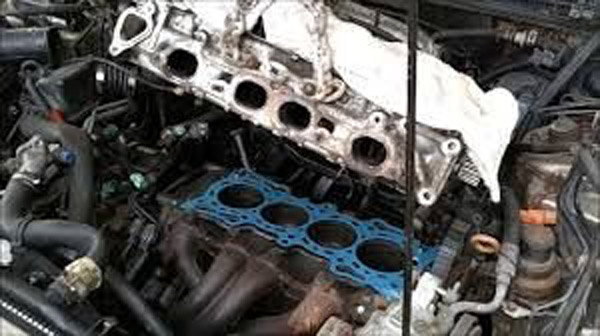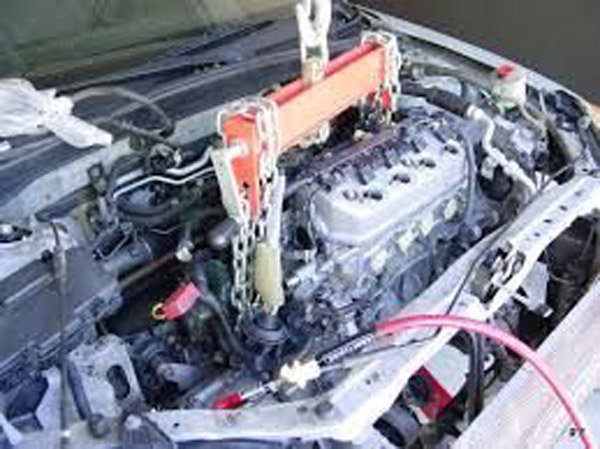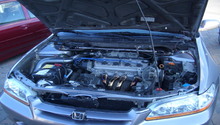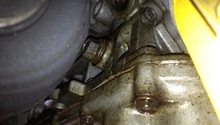Honda Accord: Why Does My Engine Oil Flow Into the Coolant Reservoir?
You've noticed engine oil in the coolant reservoir, but the car still runs okay?for now. This article will go through a few of the possible reasons, and what you can do to repair it before the problem gets worse.
This article applies to the Honda Accord (1990-2002).
Worn head gaskets, cracks, and mistakes by Honda are some of the causes for why oil might flow into the coolant reservoir. This article will discuss some of these problems, but brace yourself because the remedies are pretty heavy-duty. Read on for more information and the suggested actions to take.

Materials Needed
- Full metric socket set
- Feeler gauge and straight edge
- Engine hoist
- Hydraulic jack and jack stands
- Torque wrench
- Air tools and compressor
- Various gaskets and engine components (depending on the problem)
Step 1 – Is the head gasket worn?
When you have a worn head gasket (which is not common in Honda engines), there is one telltale indicator in addition to engine oil in the coolant reservoir, and that is there is also coolant in the crankcase oil. A worn head gasket would allow oil to get into the coolant, but it would also allow coolant to get into the oil. The result is white smoke blowing out from the exhaust and dead cylinders. If you have evidence of coolant in the crankcase, you can do a compression and leak-down test. If the compression in the cylinders is okay (if the ranges are between 163 and 170 PSI with an acceptable 15 to 20 PSI pressure difference between the cylinders), your head gasket is good and does not need to be replaced.
Depending on the auto shop or Honda dealership, the cost for both diagnostic tests might run anywhere between $150 to $350. With parts and labor, the cost to repair a blown head gasket starts at $500, but again depending on where you take it.

(Related Article: How to Replace Head Gasket - Honda-Tech.com)
Step 2 – Are there cracks in the head or block?
If you suspect a cracked cylinder head, do a compression test and an oil leak dye detection test. One test or the other may indicate that the source of the problem is within the cylinder head. Also, run the same tests and inspect the engine block. If you find any cracks in the head or block:
- Weld any cracks through a gas tungsten arc welding (GTAW) procedure, which is also known as tungsten inert gas (TIG). This is okay since both the cylinder head and the engine block are aluminum.
- Check the cylinder head and have it milled if it's warped. If you choose to repair the head yourself, a new head gasket will be required during reassembly. Don't forget to torque all bolts to their proper specs.
- Have a new or rebuilt engine installed. Labor costs run between $500 and $800, but adding the cost of the engine (between $600 and $2,500), the total cost of repair can be as much as $3,300. Before having the engine replaced, weigh the cost of repair to the cost of buying a new vehicle. The latter may save you more money in the end.
- Have the short block replaced or repaired at an auto shop. As this can end up costing you more than the engine itself (upwards of $3,500). Consider a complete engine overhaul or getting a new car.

Step 3 – Improperly drilled cylinder head hold-down bolt holes
In some 1998 and 1999 Accord model years with 4-cylinder engine blocks, the manufacturer drilled and tapped holes too deep for the cylinder head hold-down bolts. Holes went too far into the passages below allowing oil and coolant to mix. If you have low mileage on the engine, you can contact a Honda dealership and explain the problem. They may be willing to cover some of the cost for repair or replacement. If you are looking to replace the engine block or the entire engine, see Step 2 for the options and costs.
Related Discussions
- Worn Head Gasket Symptoms - Honda-Tech.com
- Warped Head or Block - Honda-Tech.com
- Leak Down and Compression Test - Honda-Tech.com
- Head Gasket Replacement Costs - Honda-Tech.com
- Honda Accord Torque Specs - Honda-Tech.com
- Badly Drilled Cylinder Head Hold-Down Bolt Holes - Honda-Tech.com






